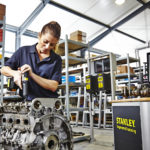~Article courtesy of STANLEY Engineered Fastening

Some studies show energy savings of up to 95% by shifting from compressed air to motor-driven tools. This is leading to a new generation of fasteners and cordless installation tools, proving ideal for use at remote worksites.
In the past, pneumatic tools promised a consistent level of power, justifying the costs of maintaining and monitoring the systems driving them. As energy costs rise and demands increase to improve operational efficiency, the cost-to-benefit ratio has diminished.
In fact, it’s been estimated that generating compressed air accounts for up to 10% of the total electricity consumption in many production facilities. Considering that on average 30% of the compressed air leaks out before getting to the end-users, operators are losing money every minute that a compressor is running.
In addition to the high volume of air wasted in air-driven production line systems, there are considerable adjacent costs associated with pneumatic systems. The hot, wet, oily air compressors produce must be conditioned to avoid contaminating downstream machinery. The oily condensate produced by compressors is also expensive to dispose of properly.
To ensure an acceptable level of efficiency in an air-powered system, proper maintenance is essential — adding further costs. Site-specific installations mean an independent electric source is required, and there’s always the risk of trailing air lines across public walkways.
While cordless tools are gaining traction in every market, the end-users of cordless equipment with the greatest impact are in the manufacturing industries. Commercial manufacturers use the same tools daily and require efficiency, reliability, and precision.
Manufacturers are also experiencing demands to increase efficiency and capacity. Forward-thinking manufacturers are meeting these demands by upgrading tools and equipment, and this is where cordless handheld tools hold an advantage over air-driven ones.
Cordless fastener tools are currently representing one of the fastest-growing segments of the battery-powered tool market for several reasons and not just cost savings.
The decision to go cordless
By some estimates, shifting from compressed air tools to motor-driven tools can result in energy savings of up to 95%. One study determined that pneumatic power tools use about seven to 13 times more energy than electric motor-driven power tools, and motor-driven tools are only becoming more efficient.
 Cordless hand tools are more cost-efficient in manufacturing operations for a few reasons. The maintenance costs of motor-driven tools are negligible and they’re extremely energy-efficient.
Cordless hand tools are more cost-efficient in manufacturing operations for a few reasons. The maintenance costs of motor-driven tools are negligible and they’re extremely energy-efficient.
There’s no wasted energy like with air-driven systems. Companies also enjoy a lower incidence of workplace safety incidents caused by the hoses attached to air-driven tools, leading to fewer liabilities and risks of costly payouts.
The environment is another consideration. Cordless tools produce better working conditions than air-driven tools, from reduced noise production to improved air quality. Motor-driven tools are considered “cleaner” because they generate no oily by-products. Such oil-free operation means there’s no hazardous waste to manage, such as the oily wastewater caused by industrial pneumatic systems.
As environmental regulations change, compliance can be costly for production facilities using air-driven tools and require expensive equipment upgrades.
Cutting the cord
There are few places where user experience is more important than in the manufacturing industry, where reliability is essential and repeated tool use is commonplace.
Two of the most compelling reasons users favor cordless tools are versatility and mobility. Cordless tools are untethered to a centralized air system, making them easy to take to remote sites (such as wind or solar energy projects).
The lack of a cord at a work site allows operators freedom of movement and increased ergonomic efficiency. The mobility and advanced features of battery-operated tools give operators the ability to be used to assemble multiple products on a single line.
Tool users are often subject to long hours of repetitive motions. Comfort and ergonomics are critical to worker longevity. Data from a McMaster University study comparing battery-operated and pneumatic tools suggests that using cordless tools reduces the demand on the forearms during use.
Research has also positively correlated hand-arm vibration from pneumatic tools with permanent hearing loss independent of noise exposure. Overall, battery-operated tools are the safer bet, reducing trips from cords and overuse injuries due to vibration.
Meeting demands
With demand for cordless tools in manufacturing at an all-time high, advances in tooling are providing new options.
The latest smart tools provide adjustable settings and performance-tracking features that make it possible to shift from one task to another with the same tool. Alerts let operators know when fasteners are inadequately tightened or torque specs are not met. Such error prevention features ensure every stroke or pull is precise and to spec, reducing manufacturing defects.

A new generation of cordless tools is designed to be “one battery fits all,” meaning that with the same battery, you can operate a fastening tool and a wide range of other tools, offering flexibility and convenience.
The newest generation of cordless tools is free of past limitations: they deliver more accurate torque, repeatability, and reliability than ever before.
Safety check
Before using a tool, first ask:
- Is this the ideal tool for the job? The wrong choice increases the risk of accidents and injuries.
- Is the tool safe to use? Does it have damage or any faults that could lead to mechanical hazards?
- Has the tool been maintained and tested? Power tools are typically used in harsh environments and should be regularly maintained.
- Is the environment safe for the use of the tool?
- Do you have the proper safety gear?









Tell Us What You Think!